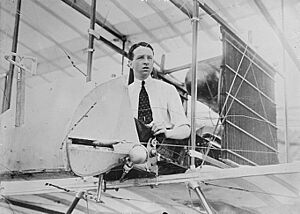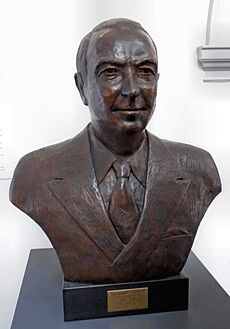Thomas Sopwith facts for kids
Quick facts for kids
Thomas Sopwith
CBE, Hon FRAeS
|
|
|---|---|

Sopwith in 1911
|
|
| Born |
Thomas Octave Murdoch Sopwith
18 January 1888 Kensington, London, United Kingdom
|
| Died | 27 January 1989 (aged 101) Hampshire, United Kingdom
|
| Resting place | Little Somborne, United Kingdom |
| Occupation | Aviator and businessman |
| Years active | 1910–1980 |
| Organization |
|
| Spouse(s) |
Beatrix Hore-Ruthven
(m. 1914; died 1930)Phyllis Brodie
(m. 1932; died 1978) |
| Children | Thomas E.B. Sopwith |
| Medal record | ||
|---|---|---|
| Representing |
||
| Men's ice hockey | ||
| European Championships | ||
| Gold | 1910 | Great Britain |
Sir Thomas Octave Murdoch Sopwith (born January 18, 1888 – died January 27, 1989) was a famous British aviation pioneer, a smart businessman, and a skilled yachtsman. He was known for his work with airplanes and for his love of sailing. He was also awarded the CBE and later became a Knight Bachelor, earning him the title "Sir."
Contents
Early Life and Interests
Thomas Sopwith was born in Kensington, London, on January 18, 1888. He was the eighth child and only son of Thomas Sopwith, who was an engineer. His grandfather, also named Thomas Sopwith, was a well-known mining engineer. Young Thomas went to school at Cottesmore School and later studied engineering at Seafield Park.
A sad event happened when Thomas was ten years old. During a family holiday in Scotland, his father passed away in an accident. This event stayed with Sopwith throughout his life.
From a young age, Sopwith loved anything with an engine. He was very interested in motorcycles and even took part in a 100-mile motorcycle trial in 1904. He also enjoyed ballooning, taking his first ride in a balloon in 1906. He even bought his own balloon with a friend. For a while, he sold cars with a partner in London.
Sopwith was also a talented ice skater. He played as a goalie for the Princes Ice Hockey Club. He was part of the Great Britain national ice hockey team that won the gold medal at the first European Championships in 1910.
Aviation Career
Sopwith became fascinated with flying after seeing another pilot, John Moisant, fly across the English Channel. He took his first flight with Gustave Blondeau. Soon, he taught himself to fly a Howard Wright Avis monoplane. His first solo flight was on October 22, 1910. Even though he crashed, he quickly got better. On November 22, he earned his pilot's license, becoming one of the first people in Britain to do so.
On December 18, 1910, Sopwith won a big prize of £4000. This was for the longest flight from England to another country in a British-built airplane. He flew 169 miles (272 km) in 3 hours and 40 minutes. He used this prize money to start his own flying school at Brooklands.
Sopwith Aviation Company
In June 1912, Sopwith, along with his chief engineer Fred Sigrist, started the Sopwith Aviation Company. They began at Brooklands but soon moved to a larger factory in Kingston upon Thames. Today, part of the original building still stands, with special bay windows designed to let in lots of light for making aircraft blueprints.
The Sopwith Aviation Company became very important during World War I. They built over 18,000 aircraft for the Allied forces. One of their most famous planes was the Sopwith Camel, a single-seat fighter plane. They built 5,747 of these! Because of his great contributions, Sopwith was awarded the CBE in 1918.
After the war, the company faced financial problems. Sopwith then started a new aviation company in 1920, named after his chief test pilot, Harry Hawker. This new company was called Hawker Aircraft, and Sopwith became its chairman.
He was knighted in 1953, which is why he was called "Sir Thomas." Even after his company became part of a larger group called Hawker Siddeley in 1977, he continued to work as a consultant until 1980. In 1979, he was honored by being inducted into the International Air & Space Hall of Fame.
Yachting Adventures
Sopwith was also a passionate yachtsman. He loved sailing and even challenged for the America's Cup, a famous international sailing race. He competed with his J-class yachts, Endeavour in 1934 and Endeavour II in 1937. Both yachts were designed by Charles E. Nicholson. Sopwith paid for, organized, and steered the yachts himself. Even though he didn't win the Cup, he almost did in 1934, becoming a legend in the race's history. He was inducted into the America's Cup Hall of Fame in 1995.
Luxury Yachts
In 1927, Sopwith ordered a luxury motor yacht named Vita. He sold it a few years later. During World War II, the British Royal Navy used the yacht to carry supplies. Sadly, it caught fire and sank in 1946.
In 1937, Sopwith received another yacht called Philante. This ship was also used by the Royal Navy during the Second World War as a convoy escort vessel, helping to protect other ships. After the war, Sopwith sold Philante to Norway in 1947. It then became the royal yacht for the King of Norway.
Personal Life
Thomas Sopwith married Beatrice Hore-Ruthven in 1914. They did not have any children. After Beatrice passed away in 1930, he married Phyllis Brodie Gordon in 1932. They had a son named Thomas Edward Brodie Sopwith, who became a successful car racing driver.
Sopwith lived in a house in Mayfair, London, from 1934 to 1940. A special blue plaque marks this house today. He then moved to Warfield Hall in Berkshire.
On his 100th birthday, military aircraft flew over his home to celebrate. Sir Thomas Sopwith passed away in Hampshire on January 27, 1989, just nine days after his 101st birthday. He is buried with his second wife in the churchyard of All Saints Church, Little Somborne.
Legacy and Tributes
Sir Thomas Sopwith's life story is told in a book called Pure Luck (2005). There is also an interview with him in a book called Voices in Flight.
Many tributes have been made to honor Sir Thomas Sopwith. In 2014, a bronze bust (a sculpture of his head and shoulders) was placed at Kingston Library in London. His son helped unveil it. Also in 2014, a plaque was put up at Canbury Gardens in Kingston upon Thames to remember the Sopwith Aviation Company.
Several roads have been named after him, including Sopwith Way in Kingston upon Thames and Sopwith Road in Warfield, Berkshire. These names help us remember his amazing contributions to aviation and his adventurous spirit.
Images for kids
See also
 In Spanish: Thomas Sopwith para niños
In Spanish: Thomas Sopwith para niños








